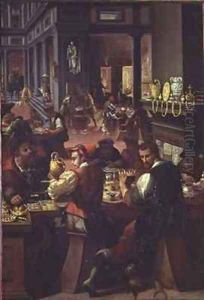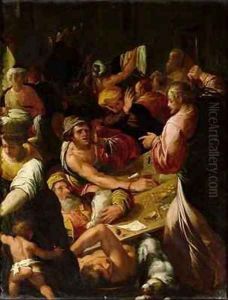Alessandro di Vincenzio Fei Paintings
Alessandro di Vincenzio Fei, also known as Alessandro Allori, was an Italian portrait and fresco painter during the late Renaissance period. Born in 1543 in Florence, he was initially named Alessandro Fei but later took the surname of his mentor, Agnolo Bronzino, who was a leading Mannerist painter and a successor to Pontormo. Allori was orphaned at the age of five and was subsequently adopted by Bronzino, who trained the young artist in the fundamentals of painting, ensuring that he received a comprehensive education in the arts.
Allori's work is characterized by its technical proficiency and a certain adherence to the Mannerist style, which is noted for its artificially elegant and sometimes contorted figures, as well as its emphasis on style over substance or emotional depth. Nonetheless, Allori's paintings also show a transition toward the more naturalistic approach that would be fully realized during the Baroque period. He became one of the most important painters in Florence following the death of his adoptive father, Bronzino.
In addition to his portraits, which were highly regarded for their detail and psychological insight, Allori was also known for his religious compositions. His works can be found in many churches and collections in Florence and throughout Italy. Some of his notable works include the 'Chios Massacre' and the 'Dead Christ Mourned by the Madonna and Saints'. The former is particularly famous for its dramatic intensity and masterful composition.
Allori was not just a painter but also an educator. He took on many pupils, the most famous of whom was his own son, Cristofano Allori, who would also go on to become a painter of great renown. Throughout his career, Alessandro Allori contributed to the decoration of various significant buildings in Florence, including the Palazzo Salviati and the Palazzo Pitti.
He died in 1592 in Florence and was buried in the Church of San Marco, leaving behind a legacy that would influence the transition from the Mannerist to the Baroque style in Italian painting. His works continue to be studied and appreciated for their craftsmanship and place in the evolution of Western art.

